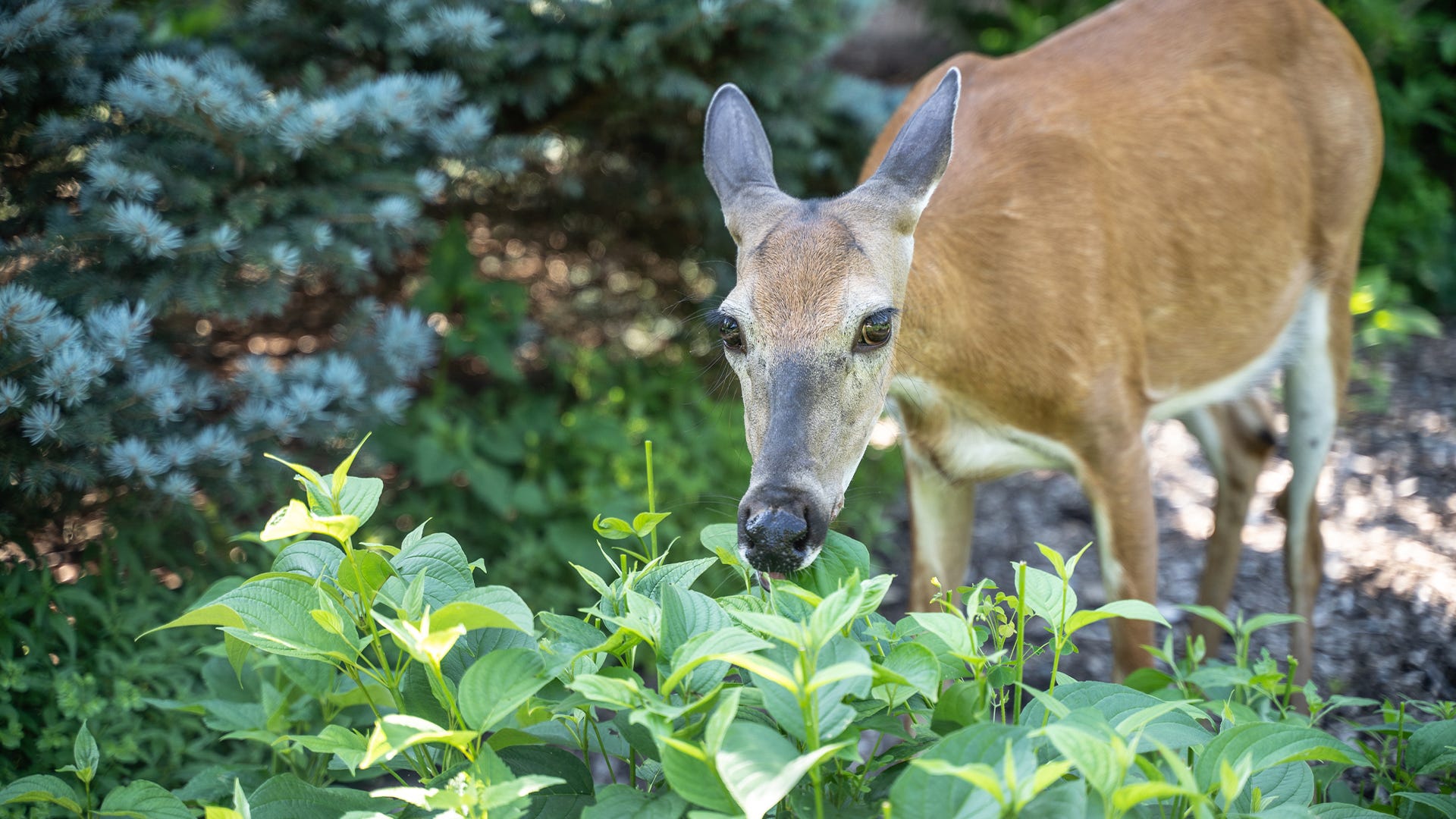While cute to look at, deer can be a menace in the garden. Not only will they devour your plants and vegetables, but they will also trample the flowerbeds flat; while doing so they can completely destroy a garden overnight. If you want to learn how to keep deer out of your garden, look no further. Read on to discover a number of helpful tips that will help to keep deer at bay, including the use of effective deer repellents such as Critter Ridder® Motion Activated Animal Repellent.
Develop a Selective Planting Strategy
One strategy that helps to answer how to keep deer out of gardens presents itself when choosing the species of plants that you plant in your garden. Steer away from aromatic, tasty plants that attract deer, and rather opt for plants that are less appealing to them. Choose plants that are full of thorns, that are very prickly, or whose leaves are covered with lots of fine hairs; these plants have a natural defense against herbivores, and deer will find them unappealing, consequently leaving them alone.
If you really must plant species that are favored by deer in your garden, plant these close to the home, as deer are less inclined to approach high traffic areas. In order to mask the fragrance of aromatic plants that would otherwise entice deer, gardeners can plant herbs that have a very pungent smell – garlic, chives, mint, and lavender all give off a powerful fragrance, but they are not favored by deer and can be used to mask the scent of more favorable plant species.
- Pros: Cost effective, natural and organic method of repelling deer.
- Cons: Difficult to implement in established gardens, and not always practical. Limits the options of what kind of plants you can have in your garden.
Deterring Deer with Deer Repellents
Deer repellents come in several forms: contact repellents, area repellents, electronic repellents, and more. Contact repellents are foul tasting and are applied directly to plants to deter deer from eating them. Area repellents have a pungent odor that deters deer due to the offensive smell they emit.
While there are several different types of electronic repellents, they are typically motion activated and spray a mist of water when an animal approaches the guarded area. Deer repellents can be homemade, or you can choose to buy a product already on the market.
Homemade Deer Repellents
There are a number of different homemade deer repellents that are suggested to keep deer at bay. Deer have a finely tuned sense of smell, and consequently many home brewed deer repellents use strong odors as a deterrent. Concoctions made from a mixture of garlic and rotten eggs are common ingredients used in deer repellents. This works as both a contact and area repellent, as the garlic/rotten egg combination has both a foul taste and smell.
Some have suggested that strips of fabric softener, bars of strongly scented soap, rags soaked in ammonia, or bags of human hair hung from trees will also deter deer. Urine from predators, such as coyote, has proved to be effective in keeping deer away from an area. Hot pepper sprays are also reported to be effective at keeping deer away from plants, while watered down hot sauce, Tabasco sauce, and habanero peppers applied directly to plants can also be used as effective contact repellents.
Depending on what ingredients you have on hand or might buy, the cost can range from $5 to $20 for a single application of repellent that may cover 50 square feet. Homemade recipes appear cost effective at first, however they need reapplied fairly often and can lead to a greater expense overall.
- Pros: Cost effective, and can be concocted from readily available ingredients.
- Cons: Time consuming to mix potions. Repellents will need to be manually applied to plants or garden beds, and will need to be reapplied after rainfall. Not always effective at repelling deer. Strong odors can be undesirable and if the mixture continually needs reapplied, it can become costly.
Commercial Deer Repellents
To save you the hassle of trying to concoct the perfect deer repellent, there are many commercial deer repellent products readily available on the market in powder or spray form, which have been tested and proved to repel deer. These repellents need to be applied from the ground up to a height of 6 feet. The repellent needs to be placed on or around the area from which you would like to keep deer away. Prices can range from $15 to $30 for a ready to use bottle of deer repellent spray. A bottle of 32 oz approximately covers 500 square feet per bottle.
- Pros: Less expensive, convenient, and readily available.
- Cons: Have to manually apply the repellent to plants or garden beds, and will need to reapply after rainfall.
Electronic Deer Repellents
A variety of electronic deer repellents can be employed to deter deer, including motion activated sensor lights and motion activated sensor sprinklers. A relatively new innovation is an electronic deer repellent that works like an electric fence, but is wireless and offers a completely portable solution for deterring deer. These repellents range in price from $60 to $150. Another form of an electronic repellent is a device that emits a spray of water if the motion sensor is tripped. This method is organic and does not cause harm to the deer, pets, children or the environment. This type of product normally ranges in price from $100 to $180.
A preferred electronic solution is a motion-activated sprinkler. Unlike other types of electronic solutions, this does not shock deer – it only startles them and effectively scares them off. Here’s how they work: they use infrared sensors to detect movement, and once they “see” an animal, they immediately activate their sprinkler function, releasing a quick burst of water.
Combined with the noise and sudden movement of the sprinkler, this spray of water scares deer and other nuisance animals away – safely and effectively. Havahart® has a line of these called Spray Away®, which have some really great features for customization to your property.
- Pros: These methods have the added benefit that they will work all year round, are waterproof and unlike many deer repellents, won’t become ineffective if it rains. After the initial purchase, they do not need to be replenished. They are effective at keeping a variety of animals out of your garden.
- Cons: Depending on the method employed, they can be quite obtrusive, and may require an initial cost outlay.
Keep Out Deer with Fencing
Traditional fencing can help to keep deer out of your garden, however they are not impenetrable; deer can easily chew holes through netting and can find ways around physical barriers.
Electric fencing also offers an effective solution for keeping deer out of an area. Electric fencing for deer can consist of multi-strand electric fencing or electric netting – both offer effective options for deer exclusion. Electric fences range from $50 to $200 depending on the area of coverage.
- Pros: Very effective method of completely excluding deer from an area. Low running costs after initial purchase of fencing components. Works all year round in any weather condition. Electric fencing will keep out a variety of animals from your garden.
- Cons: Initial outlay cost may be relatively high. May not be aesthetically pleasing to have an electric fence in a garden.
Deer can cause tremendous damage to your garden if you do not take the necessary precautions to protect your garden from wildlife. Whether you choose to use repellents, electric fencing, or a homemade product, make sure that you choose a product and a strategy for keeping deer out of your garden that is right for you and your situation.




